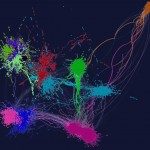Link to Pubmed [PMID] – 19854056
Trends Cell Biol. 2009 Dec;19(12):716-24
Dramatic chromosome motion is a characteristic of mid-prophase of meiosis that is observed across broadly divergent eukaryotic phyla. Although the specific mechanisms underlying chromosome motions vary among organisms studied to date, the outcome is similar in all cases: vigorous back-and-forth movement (as fast as approximately 1mum/sec for budding yeast), led by chromosome ends (or near-end regions), and directed by cytoskeletal components via direct association through the nuclear envelope. The exact role(s) of these movements remains unknown, although an idea gaining currency is that movement serves as a stringency factor, eliminating unwanted inter-chromosomal associations or entanglements that have arisen as part of the homolog pairing process and, potentially, unwanted associations of chromatin with the nuclear envelope. Turbulent chromosome movements observed during bipolar orientation of chromosomes for segregation could also serve similar roles during mitosis. Recent advances shed light on the contribution of protein complexes involved in the meiotic movements in chromosome dynamics during the mitotic program.
